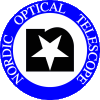











|
ALFOSC photometric zero point monitoring
Setup:
- ALFOSC
- "standard" filters (U#7, B#74, V#75, R#76, i#12)
Weather
- no clouds
if you are not sure if it is photometric, go ahead, the reductions will show you if
it was photometric or not
Instructions:
TCS:
- pick a low-airmass star from the
catalogue (+-1.5 hours from meridian),
and preset to it (e.g. tcs.guide-object A_F11 )
- make sure you are auto guiding
- alternatively load /catalogue/alphot.cat ,
preset to the object and make sure you are auto guiding
ALFOSC:
- resetxy (if needed)
- choose filter and set appropriate TCS focus-offset
- check that all the other wheels are on open position
- expose and check, using 'QuickExam', that the peak counts of all the stars are
around 30-350 kADU or so
- do all five filters
- NOTE! No calibration frames are needed
Data analysis:
- add a comment in the end-of-night report, so I (TP) can
process the data.
| |

